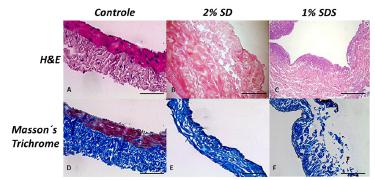Abstract
Purpose:
To investigate the ultrastructural characteristics and analysis of residual DNA in scaffold models, produced with decellularized vena cava in an experimental model with rabbits.
Methods:
Three groups were created for ultrastructural and residual DNA analysis: group 1 - control, consisting of samples of vena cava in natura; group 2 - SD, consisting of vein fragments submitted to 2% sodium deoxycholate decellularization by shaking (160rpm - Shaker News Brunswick Scientific®) for 1 hour at controlled temperature shaker at 37°C; group 3 - SDS, consisting of vein fragments submitted to 1% sodium dodecyl sulfate decellularization under the same previous condition, for 2 hours.
Results:
The ultrastructural matrix of the blood vessel maintained its vintegrity after either decellularization models. The results of the two quantification methods demonstrated a significant decrease in the DNA content of the decellularized vena cava samples as compared to the control samples and, differed statistically from each other, p <0.05.
Conclusion:
The 2% DS protocol for vein decellularization, in this experimental model, was considered the best protocol because it presented less amount of residual DNA without causing substantial destruction of the extracellular matrix.
Key words:
Tissue Scaffolds; Peripheral Arterial Disease; Blood Vessels; Tissue Engineering; Rabbits



